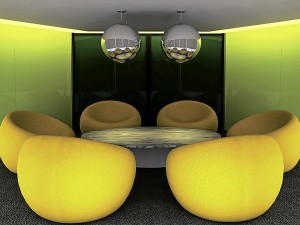
Online professional network LinkedIn’s office are probably more sedate, but they too have table tennis areas, free-for-all beverage refs, and racks of snacks and junk food—all free for the taking, and uber-colorful dining rooms for consuming all the freebies. Zappos, one of the most successful online fashion stores (for shoes, specifically), allow their staff to decorate their workstations in whatever way they want. Feel at home, so to speak. Twitter, on the other hand, has a more somber color scheme but has a flutter of bird decals on their walls.
Breakout spaces
When we designed one of the pioneer call center facilities in the country nearly 10 years ago, (Ambergris Solutions, now Telus), we introduced “bed bars” as their breakout spaces: dimmed rooms with a beverage bar, round mattresses enclosed by sheer curtain, lighting underneath the platform floors to make them seem to float, and colored lights with red, blue and yellow hues to choose from depending on the desired mood. Did people hang out there? Yes! And for the reason that they were transported from a rigid workspace into an alternate and parallel world where their minds could be more relaxed and could process work problems differently.
So, how, where and when do they actually buckle down to work?
Dr. Stuart Brown, founder of the National Institute of Play, a US company that provides consulting services for companies that want to employ the concept of play as a technique for enhancing productivity, stated that “if you allow employees to engage in something they want to do which is playful, there are better outcomes in terms of productivity and motivation.”
A playful and engaging workplace can generate a more relaxed environment, diffusing tension, reducing stress and enabling creativity to flow. But how far does one go in “kindergartening” the workplace? The Filipinos, for one, are known to be happy people. So does the innate happiness bring about a more playful personality, removing the need for a playroom environment? We’re a resilient people too! So does that translate to being able to handle stress better and to being more productive despite an uninspiring environment? Our fun-loving attitude will probably need less positive stimulus since inherently, we already have so much.
Financial outlays
Consider the financial outlays of fitting out an office as well. Many companies will find it difficult to fork out money for amusement facilities and free food and drinks, especially in our (yes, now booming) but still struggling economy. Local businesses are still many steps behind the wealthier dotcoms like Twitter and Facebook that liberally “invest” money into corporate play spaces.
This is not to say that I am against play. I myself am a playful person, and I truly believe that play in the workspace does the right side of the brain a lot of good. I cannot, for the life of me, function in an rigidly formal and serious environment. I need doses of laughter in between churning out solutions for problems and dishing out designs at work. A casual and open setting that encourages communication, interaction and the exchange of ideas are all quite enough to bring creativity, productivity and profitability to the surface. Putting all these in tangible reality will be quite challenging, yes, but that is why you have design professionals.
At the end of the day, the play mode easily kicks in when you are relaxed at home, when with friends or loved ones, or when out doing what you enjoy best. You can be that way at work too, even without the slides and fireman’s pole. When you love the work that you do and the place you work in, then a properly designed workplace naturally and spontaneously turns into your playroom. Enjoy!
Contact the author through designdimensions@abi.ph or through our Asuncion Berenguer Facebook account.